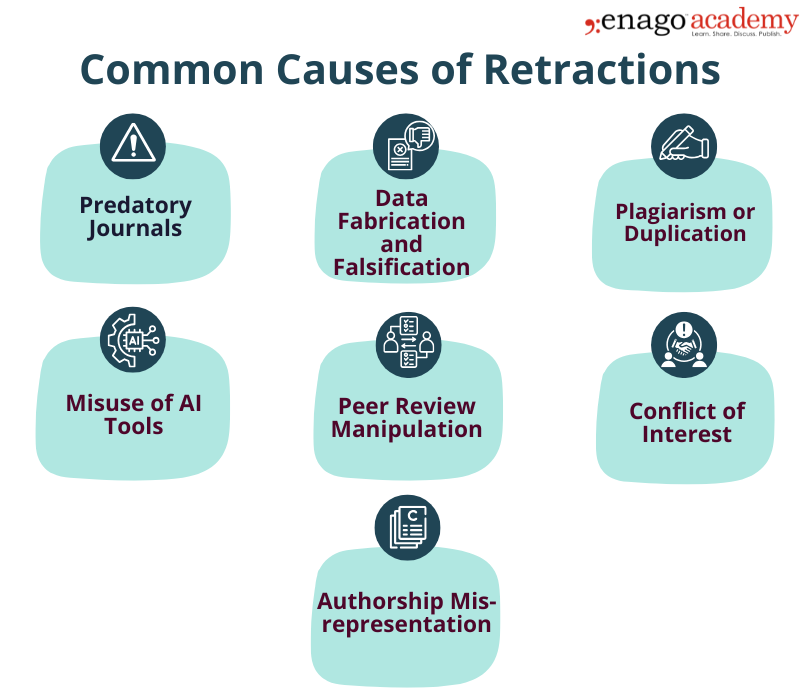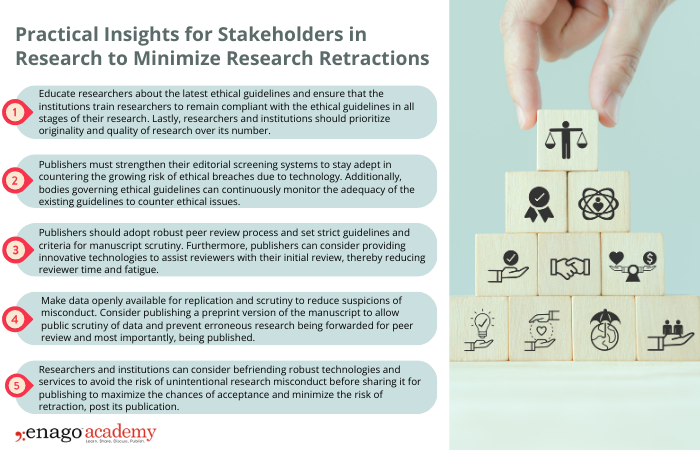Zooming Into Retractions: Understanding the global trends and proposing solutions

The number of research retractions has grown markedly over the past two decades. A recent study findings indicate that retractions for European biomedical science papers have quadrupled between 2000 and 2021. Furthermore, another study published by Nature reported over 10000 retractions in 2023 alone. This has marked a new record and startled both the academic and common community alike. Understanding the factors behind this increase, analyzing global trends, and proposing effective solutions can aid the research community in maintaining the highest standards of integrity.
Notable Cases of Retraction
Certain high-profile cases of retractions have drawn global attention, affecting not only the researchers involved but also their institutions and funding agencies. Here are a few cases that illustrate the broader implications of retractions:
- One of the most notable retractions occurred in 2020, involving a study on hydroxychloroquine’s effectiveness against COVID-19. The study, published in The Lancet, was retracted when issues were found in the data. This retraction, at the height of the pandemic, had a profound impact on public trust in medical research and government health policies.
- Several reports of corrections and retractions were issued for the researchers at Dana-Farber cancer institute after several issues were highlighted by Sholto David, a molecular biologist and an avid blogger. The institution has informed to probe into these issues and investigate the errors. However, the case highlighted the critical role of independent scrutiny in uncovering errors in high-impact research. It also emphasized the need for robust institutional oversight to uphold research integrity and prevent similar lapses.
- A study on pluripotency of mesenchymal cells being derived from adult marrow was retracted due to the lack of confidence in the reliability of the study’s data. This retraction emphasizes the importance of data reliability in groundbreaking research, particularly in regenerative medicine.
These cases highlight the serious repercussions of retractions on research integrity. Furthermore, it also demonstrates the potential setbacks to scientific progress and public trust caused by compromised data integrity. Understanding the root causes behind such retractions is crucial to addressing the issue effectively. By identifying common triggers, we can minimize their occurrence.
Common Causes of Retractions
Retractions occur for various reasons, often stemming from both intentional misconduct and unintentional errors. Here are some common causes of retractions:

As we explore the causes of retractions, it’s essential to look at the global landscape and understand which regions are most affected. Analyzing countries by their retraction rates reveal patterns that can inform effective strategies to tackle these issues on a broader scale.
Global Trends in Retractions: Top 5 countries by retraction rates
Here’s a look at six countries with most number of retractions, based on recent statistics:
China:
A Nature analysis published in February 2024 reveals the involvement of Chinese co-authors in more than 17000 retractions since 2021. Another study finding revealed reasons like discrepancies in data, result, and images, duplicate publication, paper mills, author and third-party-related reasons, plagiarism, false reviews, and method errors as reasons for retractions. To address this pressing issue, the Chinese government has launched a nationwide review of research misconduct, requiring universities to declare all retractions and report any misconduct. This action not only reflects China’s commitment in countering this problem but also sets expectations on improved ethical compliance.
Saudi Arabia:
A Nature study ranked Saudi Arabia as the top-most country with respect to the retraction rates, with 30.6 retractions per 10,000 papers over the last two decades. Another study cited plagiarism as one of the biggest reasons of retractions in Saudi Arabia, highlighting the role of plagiarism in blocking the progress of ethical research in the region. This calls the need for the universities in this region to integrate critical plagiarism checks as a part of their internal scrutiny before sharing manuscripts for publishing.
Pakistan:
A study published by Nature ranked Pakistan the second position in the list of countries with high retraction rate. 28.1 retraction per 10,000 papers were reported on analysis of more than 1 lakh studies published over the last two decades. A separate study cited fake peer reviews contributing to this issue. Although causes like pressure to publish, plagiarism, data fabrication, etc. are speculated to be the reasons of retractions in Pakistan, there is a lack of concrete studies or data analyzing the causes contributing to retractions in this region. This necessitates in-depth analysis on the factors contributing retraction to establish adequate counter-measures.
India:
Studies report that India’s retraction rates doubled as compared to the United States in around 2005. A separate study, accounted causes like plagiarism, data issues, data falsification/fabrication, duplicate submissions, authorship conflicts, fake peer review, among others. Additionally, a preprint reported a higher number of retractions of the studies published by private institutions and highlighted pressure to publish as one of the reasons. This calls the need for institutions, especially private universities to set targets in publishing research that focuses on the quality over quantity. Furthermore, it signals the need to establish stringent criteria to evaluate the quality of submissions at an institutional level.
Russia:
A Nature study ranked Russia in third among the countries with high retraction rates. It was reported that 24.9 per 10,000 papers were retracted over the last two decades. Furthermore, in 2020, Russia witnessed a significant rise in retractions, as over 800 papers were withdrawn due to widespread plagiarism and questionable authorship, as highlighted by a Russian Academy of Sciences commission. Factors contributing to this trend included normalized plagiarism, inflated academic expectations, and pay-to-publish practices. In order to counter these issues, measures like investigations and a push toward international English-language journals were introduced, aiming to improve academic standards.
The diversity in these responses highlights how several factors can play role in driving research misconduct, ultimately leading to retractions.
How to Minimize Retractions? Practical Insights for Stakeholders in Research
Here are some actionable steps for both researchers and publishers to minimize the likelihood of retractions.

From using tools like plagiarism detectors and AI content detectors at an institutional level before sending a manuscript for publishing to reducing pressure to publish and improving stringency of the screening systems, preventing retractions requires a unified effort from the stakeholders in publishing. Global coordination, through initiatives from the bodies governing ethical guidelines like COPE and meaningful collaborations across publishing houses and academic institutions, will be essential. As we look forward, a shared global standard for research integrity can not only reduce retraction rates but also foster a collaborative research culture that values transparency and accountability.









